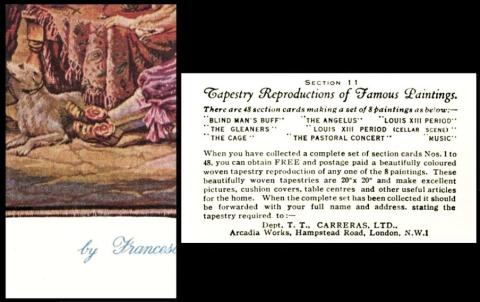
Sadly we have no reference book devoted to Carreras issues, so the only listing of this set appears in our original World Tobacco Issues Index, as :
- TAPESTRY REPRODUCTIONS OF FAMOUS PAINTINGS. Sm. 70 x 41. Sectional. Nd. (48) ... C18-69
This is repeated in our updated version, but with a new card code, of C151-385.
There are eight paintings, each of six sections, and they are listed on the back, but not the artists, which I have added below as there are actually only three, namely ;
- Francois Boucher (1703-1770)
"Blind Man`s Buff"
"Music"
"The Cage"
"The Pastoral Concert"
- Francesco Vinea (1846-1904)
"Louis XIII Period"
"Louis XIII Period (cellar scene)
- Jean-Francois Millet (1815-1875)
"The Angelus"
"The Gleaners"
The backs also tell us that "When you have collected a complete set of section cards nos 1 to 48 you can obtain FREE and postage paid a beautifully coloured woven tapestry reproduction of any one of the 8 paintings." These tapestries measured 20" x 20".
The strange thing is that these cards are pictures of tapestries, whereas the originals were paintings. This means that they must have made the tapestries, then used them to make the cards.
Hopefully they then neither made too few or too many, because I have to say that in 1938 tapestries were not exactly "on trend" with the general public. There seems to have only been one main collector, Urban Huttleston Rogers Broughton, 1st Baron Fairhaven, who was born in 1896. He, for some reason, took quite a fancy to them and used them to decorate Anglesey Abbey. His passion was the seventeenth century ones, but he also liked them so much that he had other, modern ones made, including a view of his home.
Whether this suggested the idea for this set is not known, but it seems curious that although he had collected tapestries since the 1920s, it was only after his brother`s marriage in 1932 that he was able to enlarge the property, including a grand library in 1937, where many of the tapestries hung. So it seems possible that this may have been featured in the papers, and perhaps did suggest the idea to Carreras.
